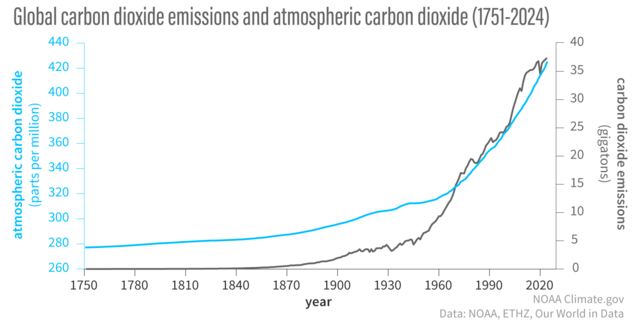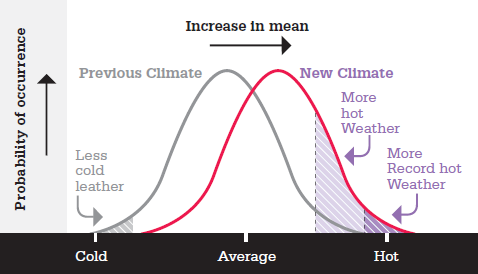Resources Topic 1: Introduction to climate change
Resources: Introduction to climate change
There are a large number of resources to explore but here are some key data about the basic science of climate change.
The graph below comes from the report Climate change: atmospheric carbon dioxide by Rebecca Lindsey in May 2025. It shows how the 'The amount of carbon dioxide in the atmosphere (blue line) has increased along with human emissions (gray line) since the start of the Industrial Revolution in 1750. Emissions rose slowly to about 5 gigatons (1 gigaton is 1 billion metric tons per year) in the mid-20th century before rapidly increasing to more than 35 billion tons per year by the end of the century.'

Have a look at these 25 cards - Everything you need to know about global warming by Brad Plumer (an informed journalist). Each of these cards are referenced and hence evidence based. Please make sure you look at Card 4 - How do we know humans are responsible for global warming as acceptance of this is key to global action. Note: these cards are now a little aged, but the information is still valid.
The Global Carbon Project's Budget is a regularly updated source of data on climate change.
The Intergovernmental Panel on Climate Change is the most authoritative source of information on climate change. Its Synthesis Report of the Sixth Assessment Report contains much information.
Headline statements can be explored here. We have picked out just two to show here:
|
Climate change is a threat to human well-being and planetary health (very high confidence). There is a rapidly closing window of opportunity to secure a liveable and sustainable future for all (very high confidence). Climate resilient development integrates adaptation and mitigation to advance sustainable development for all, and is enabled by increased international cooperation including improved access to adequate financial resources, particularly for vulnerable regions, sectors and groups, and inclusive governance and coordinated policies (high confidence). The choices and actions implemented in this decade will have impacts now and for thousands of years (high confidence). {3.1, 3.3, 4.1, 4.2, 4.3, 4.4, 4.7, 4.8, 4.9, Figure 3.1, Figure 3.3, Figure 4.2} (Figure SPM.1; Figure SPM.6) |
|
Deep, rapid and sustained mitigation and accelerated implementation of adaptation actions in this decade would reduce projected losses and damages for humans and ecosystems (very high confidence), and deliver many co-benefits, especially for air quality and health (high confidence). Delayed mitigation and adaptation action would lock-in high-emissions infrastructure, raise risks of stranded assets and cost-escalation, reduce feasibility, and increase losses and damages (high confidence). Near-term actions involve high up-front investments and potentially disruptive changes that can be lessened by a range of enabling policies (high confidence). {2.1, 2.2, 3.1, 3.2, 3.3, 3.4, 4.1, 4.2, 4.3, 4.4, 4.5, 4.6, 4.7, 4.8} |
From the epidemiologist: An important technical point, is that even a small increase in mean temperature will create a large increase in number of hot and very hot days (slide by Professor Lesley Hughes, from IPCC AR4)

You may also want to explore your own sources of information about climate change.
